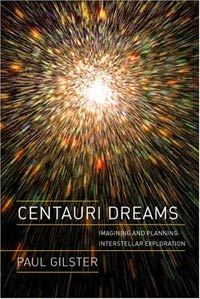Review: Centauri Dreamsby Anthony Young
|
| Voyager 1 is traveling at a speed that could take it from Los Angeles to New York in four minutes. However, at that speed, it would take over 77,000 years to reach Alpha Centauri. |
First, the question of “why?” must be answered. Although research into this subject had been going on for years, it was the successful landing of Mars Pathfinder and its successful but limited robotic mission in July of 1997 that sparked NASA to pursue bigger goals. That month NASA administrator Daniel S. Goldin announced building a robotic probe to reach another star would be a new goal for the agency. “We have to set goals so tough it hurts—that it drives technology—in semiconductors, materials, simulation, propulsion,” he said.
The topics explored by Gilster are nothing short of fantastic, but we are less incredulous of their achievement than any previous generation. The pioneers of flight could not conceive of shattering the speed of sound, yet it was achieved 44 years after Kitty Hawk. Today’s combat aircraft do this routinely. What interplanetary and interstellar speeds will be routine 50 years from now? There are several technologies being investigated to achieve this. Chief among the propulsion concepts being pursued is antimatter—no joke. “More than plausible,” Gilster writes, “antimatter is real, it is being produced [although minutely—ed.], and is under active investigation.” Solar sails are covered, as well as light sails, or laser sails, ramjets, and “fusion runways”.
There are other issues as well. Scientists working on these ideas and missions will probably never see them accomplished because the probe will take more than 40 years to get to Alpha Centauri. The people Gilster interviewed accept this fact. Communications take so long at these distances the probes must have intelligent autonomous systems and even self-repairing capability. The real payoff in present terms is the spinoff technology that will be used for future lunar and interplanetary missions. Gilster’s book is a fascinating read into the realm of the fantastic and the achievable.
